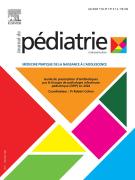Pratique de la diversification alimentaire chez les nourrissons à Antananarivo, Madagascar : relation avec leur état nutritionnel - 24/05/23
Complementary feeding practice in infants in Antananarivo, Madagascar : Relationship with their nutritional status
 , R.J. Rasamoelison b, M.Z. Ramananirina a, M.L. Rakotomahefa Narison c, A.L. Robinson d
, R.J. Rasamoelison b, M.Z. Ramananirina a, M.L. Rakotomahefa Narison c, A.L. Robinson dRésumé |
Introduction |
La diversification alimentaire est une période à risque de déséquilibres nutritionnels. L’objectif de cette étude a été de déterminer la relation entre la pratique de la diversification alimentaire et l’état nutritionnel des nourrissons.
Méthodes |
Une étude transversale a été menée du 01 au 30 Novembre 2021 au centre hospitalier universitaire mère-enfant Tsaralalana et dans 6 centres de santé de base de niveau II de la ville d’Antananarivo.
Résultats |
Ont été colligés 222 nourrissons âgés de 6–23 mois. La prévalence de l’insuffisance pondérale, de la malnutrition aiguë, de la malnutrition chronique a été respectivement de 46,9 %, 29,7 % et 34,7 %. L’âge d’initiation de la diversification alimentaire non conforme à la recommandation de l’OMS a été associé à l’insuffisance pondérale [OR=2,22 (1,27–3,88)] et à la malnutrition aiguë [OR=5,09 (2,75–9,44)]. Un score de Ruel et Menon<9 a été associé à l’insuffisance pondérale [OR=4,65 (2,53–8,53)], à la malnutrition aiguë [OR=5,57 (2,58–12,03)] et à la malnutrition chronique [OR=5,76 (2,81–11,79)]. Le non-respect du minimum alimentaire acceptable a été associé à l’insuffisance pondérale [OR=3,22 (1,80–5,71)], à l’émaciation [OR=5,57 (2,58–12,03)] et au retard de croissance [OR=4,47 (2,27–8,82)]. L’utilisation d’assiette commune a été un déterminant de l’insuffisance pondérale [OR=2,38 (1,39–4,08)], de l’émaciation [OR=2,61 (1,50–4,95)] et du retard statural [OR=2,71 (1,53–4,79)].
Conclusion |
La conduite de la diversification alimentaire influence l’état nutritionnel du nourrisson. L’amélioration des pratiques de l’alimentation du nourrisson et du jeune enfant est fondamentale dans la lutte contre la malnutrition.
Le texte complet de cet article est disponible en PDF.Summary |
Introduction |
Complementary feeding is a period at risk of nutritional disorders. The aim of this study was to determine the relationship between the complementary feeding practice and the nutritional status of infants.
Methods |
A cross-sectional study was conducted from November 01 to 30, 2021 at the Mother and Child University Hospital Center Tsaralalana and in 6 basic health centers level II in the city of Antananarivo.
Results |
Two hundred and twenty two (222) infants aged 6–23 months were collected. The prevalence of underweight, acute malnutrition and chronic malnutrition were respectively 46.9 %, 29.7 % and 34.7 %. The age of initiation of complementary feeding that does not comply with the WHO recommendation has been associated with underweight [OR=2.22 (1.27–3.88)] and acute malnutrition [OR=5.09 (2.75–9.44)]. A Ruel and Menon score<9 was associated with underweight [OR=4.65 (2.53–8.53)], acute malnutrition [OR=5.57 (2.58–12, 03)] and chronic malnutrition [OR=5.76 (2.81-11.79)]. Non-compliance with the minimum acceptable diet has been associated with underweight [OR=3.22 (1.80–5.71)], wasting [OR=5.57 (2.58–12, 03)] and growth retardation [OR=4.47 (2.27–8.82)]. Common plate use was a determinant of underweight [OR=2.38 (1.39–4.08)], wasting [OR=2.61 (1.50–4, 95)] and stunting [OR=2.71 (1.53–4.79)].
Conclusion |
Complementary feeding practice influences the nutritional status of infants. Improving infant and young child feeding practices is fundamental in the fight against malnutrition.
Le texte complet de cet article est disponible en PDF.Mots clés : Alimentation, Diversification alimentaire, État nutritionnel, Madagascar, Nourrisson
Keywords : Complementary feeding, Diet, Infant, Nutritional status, Madagascar
Plan
Vol 36 - N° 3
P. 107-113 - juin 2023 Retour au numéroBienvenue sur EM-consulte, la référence des professionnels de santé.
L’accès au texte intégral de cet article nécessite un abonnement.
Déjà abonné à cette revue ?

